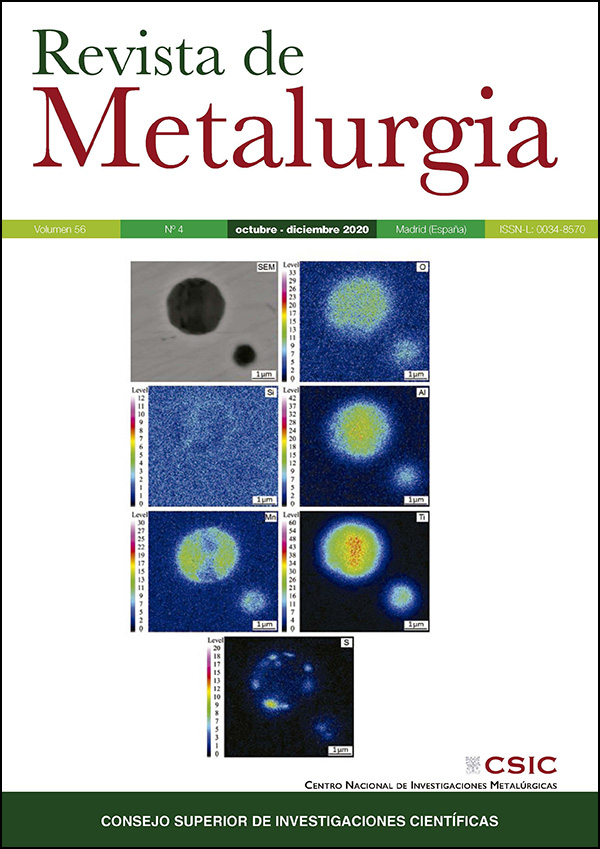La eliminación de metales tóxicos presentes en efluentes líquidos mediante resinas de cambio iónico. Parte XIV: Indium(III)/H+/Dowex-400
DOI:
https://doi.org/10.3989/revmetalm.184Palabras clave:
Dowex-400, Efluentes líquidos, Eliminación, Indio(III)Resumen
Se ha estudiado la eliminación del indio(III), de medios acuosos, mediante la resina de intercambio catiónico Dowex-400 midiendo el tanto por ciento de esta eliminación en función de la dosificación de resina y el pH de la disolución acuosa. La velocidad de agitación (300-1000 min−1) aplicada al sistema no tiene influencia sobre la eliminación del indio(III) de la disolución, estando el proceso de carga del metal en la resina asociado a un modelo de difusión en la disolución. La eliminación del metal de la disolución disminuye con la disminución del valor del pH. El proceso de intercambio es exotérmico (ΔH°= -90 kJ·mol−1), y siendo el modelo cinético dependiente de la temperatura: seudo-primer orden a 20 °C, segundo orden a 30 °C y seudo-segundo orden a 40 °C. La isoterma de Langmuir de tipo-2 es el modelo que mejor representa al proceso de carga del metal en la resina. El indio(III) cargado en la resina puede ser eluido mediante disoluciones acidas, regenerándose, al mismo tiempo, la resina.
Descargas
Citas
Alguacil, F.J., Coedo, A.G., Dorado, T., Padilla, I. (2002). The removal of toxic metals from liquid effluents by ion exchange resins. Part I: chromium(VI)/sulphate/Dowex 1x8. Rev. Metal. 38, 306-311. https://doi.org/10.3989/revmetalm.2002.v38.i4.412
Alguacil, F.J. (2002). The removal of toxic metals from liquid effluents by ion exchange resins. Part II: cadmium(II)/sulphate/Lewatit TP260. Rev. Metal. 38, 348-352. https://doi.org/10.3989/revmetalm.2002.v38.i5.418
Alguacil, F.J. (2003). The removal of toxic metals from liquid effluents by ion exchange resins. Part III: copper(II)/sulphate/Amberlite 200. Rev. Metal. 39, 205-209. https://doi.org/10.3989/revmetalm.2003.v39.i3.330
Alguacil, F.J. (2017a). The removal of toxic metals from liquid effluents by ion exchange resins. Part IV: chromium(III)/H+/Lewatit SP112. Rev. Metal. 53 (2), e093.
Alguacil, F.J. (2017b). The removal of toxic metals from liquid effluents by ion exchange resins. Part V: nickel(II)/H+/Dowex C400. Rev. Metal. 53 (4), e105.
Alguacil, F.J. (2018a). The removal of toxic metals from liquid effluents by ion exchange resins. Part VI: manganese(II)/H+/Lewatit K2621. Rev. Metal. 54 (2), e116.
Alguacil, F.J. (2018b). The removal of toxic metals from liquid effluents by ion exchange resins. Part VII: manganese(VII)/H+/Amberlite 958. Rev. Metal. 54 (3), e125.
Alguacil, F.J., Escudero, E. (2018). The removal of toxic metals from liquid effluents by ion exchange resins. Part VIII: Arsenic(III)/OH−/Dowex 1x8. Rev. Metal. 54 (4), e132.
Alguacil, F.J. (2019a). The removal of toxic metals from liquid effluents by ion exchange resins. Part IX: lead(II)/H+/Amberlite IR120. Rev. Metal. 55 (1), e138.
Alguacil, F.J. (2019b). The removal of toxic metals from liquid effluents by ion exchange resins. Part X: antimony(III)/H+/Ionac SR7. Rev. Metal. 55 (3), e152.
Alguacil, F.J. (2019c). The removal of toxic metals from liquid effluents by ion exchange resins. Part XI: cobalt(II)/H+/Lewatit TP260. Rev. Metal. 55 (4), e154.
Alguacil, F.J., Escudero, E. (2019). Solvent extraction of indium(III) from HCl solutions by the ionic liquid (A324H+)(Cl−) dissolved in Solvesso 100. Hydrometallurgy 189, 105104. https://doi.org/10.1016/j.hydromet.2019.105104
Alguacil, F.J., Escudero, E. (2020). The removal of toxic metals from liquid effluents by ion exchange resins. Part XII: mercury(II)/H+/Lewatit SP112. Rev. Metal. 56 (1), e160.
Alguacil, F.J. (2020). The removal of toxic metals from liquid effluents by ion exchange resins. Part XIII: zinc(II)/H+/ Lewatit OC-1026. Rev. Metal 56 (3), e172.
Araucz, K., Aurich, A., Kotodynska, D. (2020). Novel multiofunctional ion exchangers fro metal ions removal in the presence of citric acid. Chemosphere 251, 126332. https://doi.org/10.1016/j.chemosphere.2020.126331 PMid:32145572
Bayazit, G., Tastan, B,E, Gül, U.D. (2020). Biosorption, isotherm and kinetic properties of common textile dye by Phormidium animale. Global NEST J. 22 (1), 1-7.
Bezzina, J.P., Robshaw, T., Dawson, R., Ogden, M.D. (2020). Single metal isotherm study of the ion exchange removal of Cu(II), Fe(II), Pb(II) and Zn(II) from synthetic acetic acid leachate. Chem. Eng. J. 394, 124862. https://doi.org/10.1016/j.cej.2020.124862
Hubbe, M.A., Azizian, S., Douven, S. (2019). Implications of apparent pseudo-second-order adsorption kinetics onto cellulosic materials: a review. BioResources 14 (3), 7582-7626. https://doi.org/10.15376/biores.14.3.7582-7626
Jacukowicz-Sobala, J., Ocinski, D., Mazur, P., Stanislawska, E., Kociolak-Balawejder, E. (2020). Cu(II)-Fe(III) oxide doped anion exchangers-Multifunctional composites for arsenite removal from water as As(III) adsorption ands oxidation. J. Hazard. Mater. 394, 122527. https://doi.org/10.1016/j.jhazmat.2020.122527 PMid:32199203
Lee, J.-C., Kurniawan, Hong, H.-J. Chuong, K.W., Kim, S. (2020). Separation of platinum, palladium and rhodium from aqueous solutions using ion exchange resins: A review. Sep. Purif. Technol. 246, 116896. https://doi.org/10.1016/j.seppur.2020.116896
Lopez Diaz-Pavon, A., Cerpa, A., Alguacil, F.J. (2014). Processing of indium(III) solutions via ion exchange with Lewatit K-2621 resin. Rev. Metal. 50 (2), e010. https://doi.org/10.3989/revmetalm.010
Luz, A.L., Wu, X., Tokar, E.J. (2018). Toxicology of Inorganic Carcinogens (Chapter One). Adv. Molec. Toxicol. 12, 1-46. https://doi.org/10.1016/B978-0-444-64199-1.00002-6
Simonescu, C.M., Lavric, V., Musina, A., Antonescu, O.M., Culita, D.C., Marinescu, V., Tardei, C., Oprea, O., Oandele, A.M. (2020). Experimenatl and modeling of cadmium ions by chelating resins. J. Mol. Liq. 307, 112973. https://doi.org/10.1016/j.molliq.2020.112973
Schuyler Anderson, C. (2020). US Geological Survey, Accessed May 2020. https://pubs.usgs.gov.
Publicado
Cómo citar
Número
Sección
Licencia
Derechos de autor 2020 Consejo Superior de Investigaciones Científicas (CSIC)

Esta obra está bajo una licencia internacional Creative Commons Atribución 4.0.
© CSIC. Los originales publicados en las ediciones impresa y electrónica de esta Revista son propiedad del Consejo Superior de Investigaciones Científicas, siendo necesario citar la procedencia en cualquier reproducción parcial o total.
Salvo indicación contraria, todos los contenidos de la edición electrónica se distribuyen bajo una licencia de uso y distribución “Creative Commons Reconocimiento 4.0 Internacional ” (CC BY 4.0). Consulte la versión informativa y el texto legal de la licencia. Esta circunstancia ha de hacerse constar expresamente de esta forma cuando sea necesario.
No se autoriza el depósito en repositorios, páginas web personales o similares de cualquier otra versión distinta a la publicada por el editor.
















